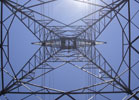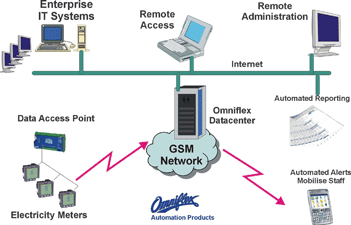

With the cost of energy and power rising and power saving becoming an issue at the forefront of management minds the application of monitoring technologies comes to the fore. Since all enterprises are billed on their usage of power by Eskom or respective municipalities on a monthly basis through meter readings, the surprise comes at month end when the bill arrives and it is too late to manage anything. Many plants do monitor the bulk supply and even have check meters in place to verify the billing meter, however, getting access to the data on say an hourly basis can be problematic, and in addition, usage to key areas is unknown in many cases, and deemed to be an expensive exercise.
The issues are:
* No reporting to management for corrective action.
* Metering is done at bulk level (main feeders) and many enterprises have several bulk connections.
* Access to meter readings is difficult.
* Consolidation of data is difficult.
* Remote meters are difficult to reach with communications networks.
* No resolution, allocation or aggregation within the organisation of power consumption by area.
* High cost of implementing new systems.
* Large distributed organisations cannot easily consolidate the utilities bill over a group.
* Benchmarking plants with one another (how efficient are we?).
Omniflex has developed a system of Scaleable Telemetry Outstations for GSM cellular networks to support general packet radio service (GPRS) transmission of data from remote outstations that require monitoring. “The suitability of GSM networks has become a reality due to their coverage, reliability and low cost of ownership,” comments Ian Loudon, Omniflex sales manager. “There is no infrastructure cost to consider as you have with in-house-based systems and you can extend your monitoring country-wide – in fact it is possible to use the technology outside the countries' borders too.”
So how hard is it to implement?
* Electricity meters are relatively inexpensive – can be fitted by in-house electrical staff.
* Remote monitoring is relatively inexpensive – installed in a day.
What is in a system?
* Intelligent power meters for monitoring the power consumption parameters where plant areas require it.
* Data access points – modular programmable remote terminal units (RTUs) from 12 to 240 inputs and a serial communications port for interfacing to electricity meters.
* Web-based monitoring for access from anywhere by anyone (with access rights).

Features
* Realtime access to data via the Internet.
* Data on management’s desk – e-mail or browse via Internet.
* Automated system reporting.
* Direct SMS to service personnel cellular phones with required acknowledgements or escalation to another phone occurs.
Loudon says that the Omniflex solution with the Web-based remote monitoring systems infrastructure integrates everything and puts data into the right hands and allows management to allocate responsibility and accountability by measuring and monitoring those resources, consolidating the information and automating the reporting process, automating the alarm notifications and empowering people to make and take decisions that save the organisation money.
Omniflex interfaces directly with plant metering equipment and by preference through serial communications eliminating duplication of measurement and any measurement errors since clients are then monitoring exactly what they are being billed for. This however is reviewed on a site by site basis according to the constraints and metering in place. Determining and apportioning utility billing requires more metering and monitoring across the plant or facilities to improve the management view of the power usage of the areas under consideration. A power audit is often the best course of action to identity the areas using the most power and thus potential for savings. The 80/20 rule applies most often in these cases and power savings can be generated without having to monitor or measure down to the lowest levels.
Many management decisions can be made by simply understanding the consumption profile and reviewing corrective action outcomes. The benefit of this is that events can be monitored on a daily or hourly basis instead of only at month end when billing takes place. Load shedding effects can thus be reviewed and optimised in realtime.
For more information contact Ian Loudon, Omniflex, +27 (0)31 207 7466, [email protected], www.omniflex.com
| Tel: | +27 31 207 7466 |
| Email: | [email protected] |
| www: | www.omniflex.com |
| Articles: | More information and articles about Omniflex Remote Monitoring Specialists |

© Technews Publishing (Pty) Ltd | All Rights Reserved